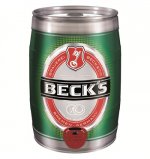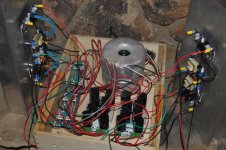Would an entire heatsink that's electrically connected to the tab, act as an antenna attracting noise and hum?
Can not isolate heatsink act as antenna and open the doors at some wifi gremlins ??
Let's keep some perspective here. A linear voltage regulator is known as the "quiet" power supply, and so to is a linear audio amplifier. And what about that word "audio"? People may quarrel about the exact range, but 20 Hz - 20 kHz (plus or minus) does NOT represent a radiating or receiving bandwidth for heat sinks of our dimensions. So, we can be confident that our amplifier will not be a radio. And if we assume that smart safety practice would consign the floating heat sink to live within a grounded enclosure to keep somebody from dropping an aluminum container of their favorite beverage into your amp and shorting out your show case, then the chance of anything radiated coupling to your heat sink in a bandwidth that matters is vanishingly small.
What about conducted interference? Well, I would argue from the established theory of conducted electromagnetic interference (EMI) that isolating the heat sink will reduce, not increase, the susceptibility of the amplifier to conducted EMI from sources outside of the amplifier (i.e., the mean ole electrical grid that your power supply is connected to).
eeerr?Let's keep some perspective here.... keep somebody from dropping an aluminum container of their favorite beverage into your amp and shorting out your show case,...
Dogfish Head does not come in aluminium containers. Not that I want them but, niether does Beck's and St.Pauly

Let's keep some perspective here...

Well, now. If we are talking hypothetically about beer, then I would submit we look at the fine country of Germany, well represented on this thread, for examples of very large aluminum containers of Beck's. Large enough to short BOTH channels!eeerr?
Dogfish Head does not come in aluminium containers. Not that I want them but, niether does Beck's and St.Pauly
Let's keep some perspective here...

Standing on more than one train platform in said country, I can attest to spotting these containers. Not that I would want one...

Dogfish Head is from Delaware. Beck's and St Pauly used to be from Germany but, it seems Beck's has licensed it to someone here now, kinda like VWs I guess.
But I also wanted to say, I to use no insulator when bench testing but I always use Arctic Silver 5 compound at the interface. Even for small pkgs like the Lovoltech Ipak types but, it's more necessary with TO-247s and TO-264s.
But I also wanted to say, I to use no insulator when bench testing but I always use Arctic Silver 5 compound at the interface. Even for small pkgs like the Lovoltech Ipak types but, it's more necessary with TO-247s and TO-264s.
Last edited:
Well, now. If we are talking hypothetically about beer, then I would submit we look at the fine country of Germany, well represented on this thread, for examples of very large aluminum containers of Beck's. Large enough to short BOTH channels!
Standing on more than one train platform in said country, I can attest to spotting these containers. Not that I would want one...
Exactly... five liter (169.07us fl oz) aluminum container is must, if you expect friends in Germany. Even better is a cooled Push-Pull pair of those kegs

For TO-220 packages dissipating 30 watts or more, I like to attach the package to a larger copper heat spreader using Arctic Silver, which I then attach to the heatsink using mica and grease.
Interesting - please explain more. How does the insulation work ? Wouldn't mica be impractical if the spreader was of any decent size bigger than the transistor package ? Did you ever get a chance to see how many degrees lower the transistor runs in this setup ?
I have only done this for TO-247 sized package footprints, but it is possible to obtain sheet mica from EBay. Other types of insulator should also work, but might require a larger spreader for the same thermal resistance.Interesting - please explain more. How does the insulation work ? Wouldn't mica be impractical if the spreader was of any decent size bigger than the transistor package ? Did you ever get a chance to see how many degrees lower the transistor runs in this setup ?
Sure. Minimize the thickness of the mica and grease. The thermal conductivity between the spreader and the heatsink increases linearly with the area of the spreader.I can see how a copper heat spreader would spread the heat out. But wouldn't the thermal resistance of the mica grease still be a problem after the copper heats up?
A good resource for mounting transistors to heatsinks is here: ESP - Heatsink design and transistor mounting
For TO-220 packages dissipating 30 watts or more, I like to attach the package to a larger copper heat spreader using Arctic Silver, which I then attach to the heatsink using mica and grease.
Where do you get big mica pieces?
Rush
This keg would make a great heatsink, but who wants warm beer
Sent from my Xperia Ion using Tapatalk 2
That's what you get at a season opening college football game in the Southeastern Conference.
Distortion Analyzer Software
When choosing a distortion analyzer software, is there any special that is required?
Was looking at True Audio.
TrueRTA Audio Spectrum Analyzer Software
When choosing a distortion analyzer software, is there any special that is required?
Was looking at True Audio.
TrueRTA Audio Spectrum Analyzer Software
Asking advice
Ok, hi there guys!
Been lurking here for some time now… but only after I’ve had a F4 on loan here for a while, did I suddenly get an urge to build a FirstWatt amp. I’m very much a DIY guy but, even after some kit building experience, I have to admit that my electric knowledge is very basic. But still I'm thinking I could probably build a F6 with some help. Help from you guys and help from a knowledgeable friend. But as it may be too much to ask the friend to figure out everything, I’m hoping you guys can set some issues strait.
I’m very much a DIY guy but, even after some kit building experience, I have to admit that my electric knowledge is very basic. But still I'm thinking I could probably build a F6 with some help. Help from you guys and help from a knowledgeable friend. But as it may be too much to ask the friend to figure out everything, I’m hoping you guys can set some issues strait.
The “recommended” circuit is the Variable 2nd harmonics version (pic attached), right? But instead of the R100 you have to use IRFP240s? Are there other parts that are so hard to get that they should be exchanged? Not planning on any mods, just the basic circuit.
The PBC board of Permaneder on post no: 3213 seems fine and quite easy as it has the values printed on the board. Any power supply board available?
Also is there anyone here who has any of the major parts to sell?
Thoughts / corrections? I’m grateful for any advice. =)
Thanks!

Ok, hi there guys!
Been lurking here for some time now… but only after I’ve had a F4 on loan here for a while, did I suddenly get an urge to build a FirstWatt amp.
The “recommended” circuit is the Variable 2nd harmonics version (pic attached), right? But instead of the R100 you have to use IRFP240s? Are there other parts that are so hard to get that they should be exchanged? Not planning on any mods, just the basic circuit.
The PBC board of Permaneder on post no: 3213 seems fine and quite easy as it has the values printed on the board. Any power supply board available?
Also is there anyone here who has any of the major parts to sell?
Thoughts / corrections? I’m grateful for any advice. =)
Thanks!
F6 is up and running -actually balanced F6
Big thanks to buzzforb who provided the boards so I could get the balanced F6 up and running. This is one sweet amp!


Voltage is +/-23V; bias is at 1A
Amp is driving the PHLs in my system (approx 300-5000Hz)
Very quiet (offset about 10mV)
Soundstage is clearly both wider and deeper than any amp I have had in my system.
Instruments have well defined place in soundstage.
Detail is amazing. I heard some things I know did not jump out like this before.
Voices are like what I remember from live acoustic performances.
Also there is no fatigue while listening
Thanks again Justin
Best
Bob
Big thanks to buzzforb who provided the boards so I could get the balanced F6 up and running. This is one sweet amp!
Voltage is +/-23V; bias is at 1A
Amp is driving the PHLs in my system (approx 300-5000Hz)
Very quiet (offset about 10mV)
Soundstage is clearly both wider and deeper than any amp I have had in my system.
Instruments have well defined place in soundstage.
Detail is amazing. I heard some things I know did not jump out like this before.
Voices are like what I remember from live acoustic performances.
Also there is no fatigue while listening
Thanks again Justin
Best
Bob
Attachments
- Home
- Amplifiers
- Pass Labs
- F6 Amplifier

